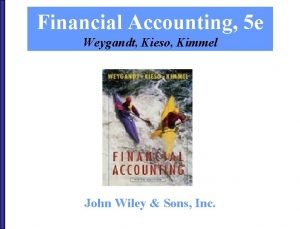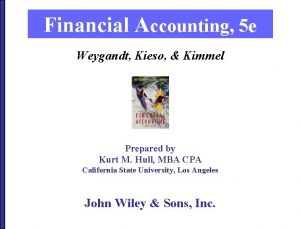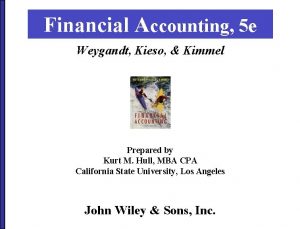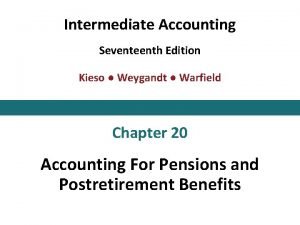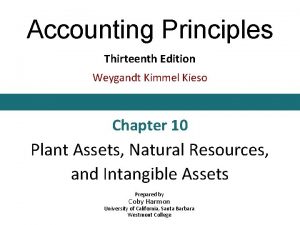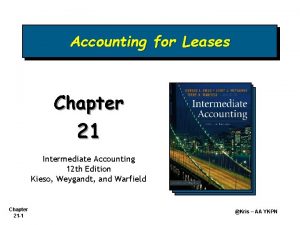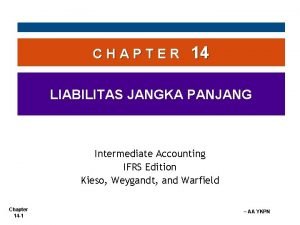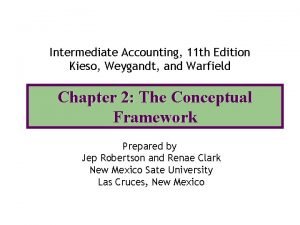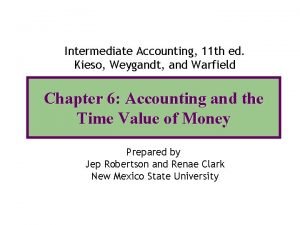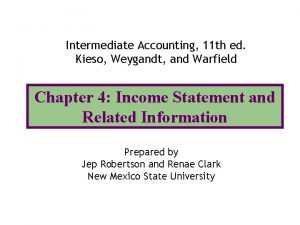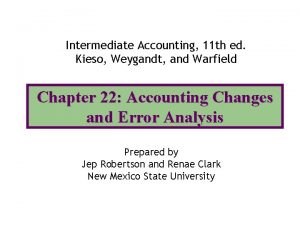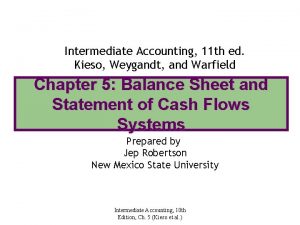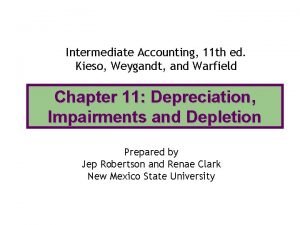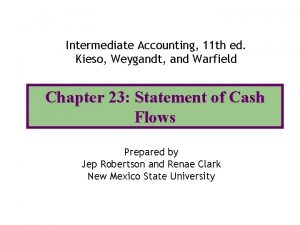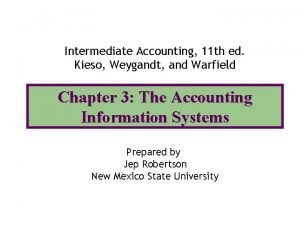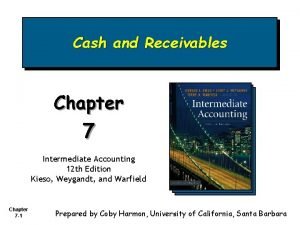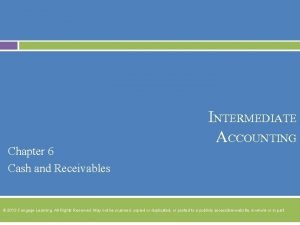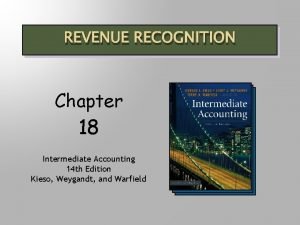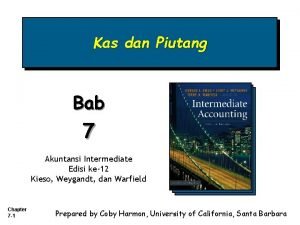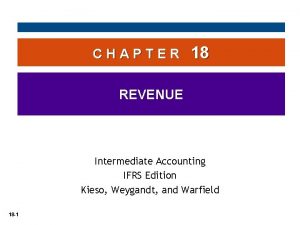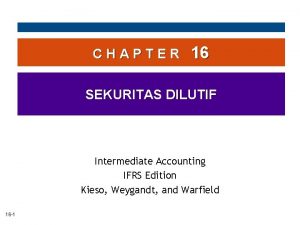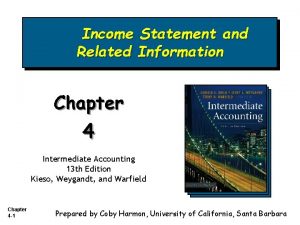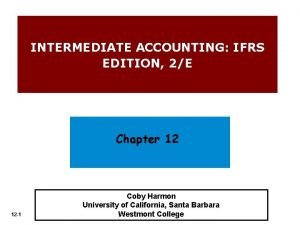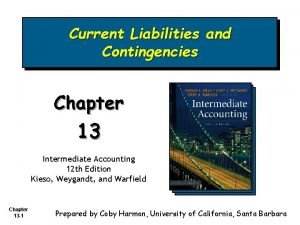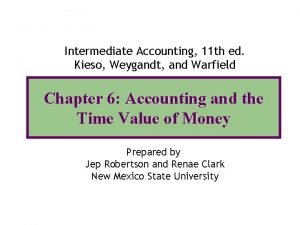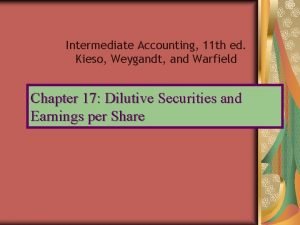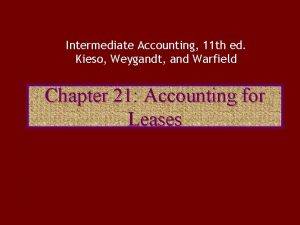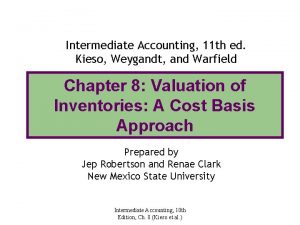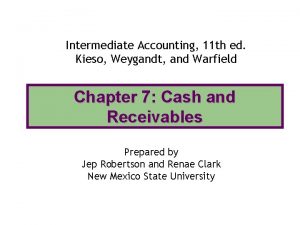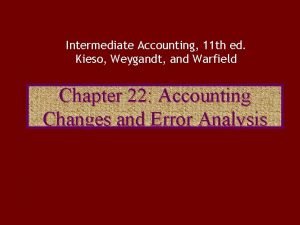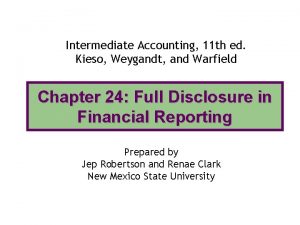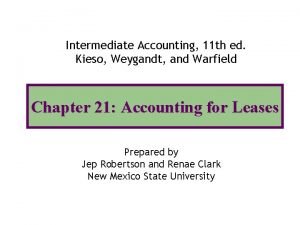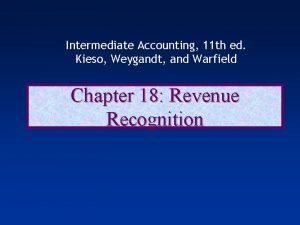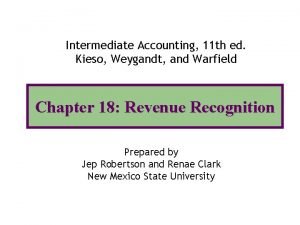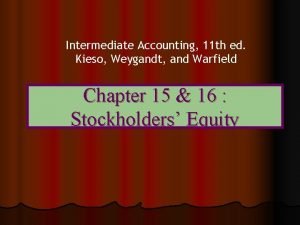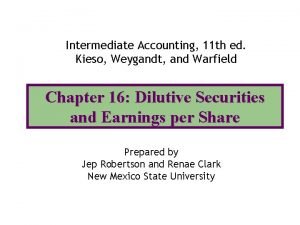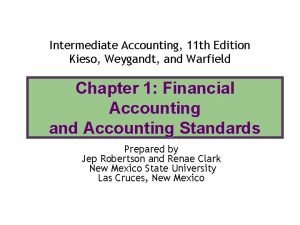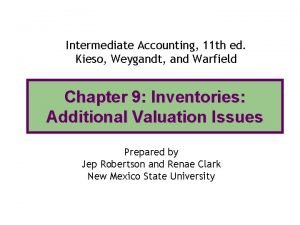Intermediate Accounting 11 th ed Kieso Weygandt and




















![Net Operating Losses [NOLs]: Basic Terminology Net operating loss is a tax terminology. A Net Operating Losses [NOLs]: Basic Terminology Net operating loss is a tax terminology. A](https://slidetodoc.com/presentation_image/1f61f635db372d1e867ad3ac3d441acc/image-21.jpg)






- Slides: 27

Intermediate Accounting, 11 th ed. Kieso, Weygandt, and Warfield Chapter 19: Accounting for Income Taxes Prepared by Jep Robertson and Renae Clark New Mexico State University

Chapter 19: Accounting for Income Taxes After studying this chapter, you should be able to: 1. Identify differences between pretax financial income and taxable income. 2. Describe a temporary difference that results in future taxable amounts. 3. Describe a temporary difference that results in future deductible amounts. 4. Explain the purpose of a deferred tax asset valuation allowance.

Chapter 19: Accounting for Income Taxes 5. Describe the presentation of income tax expense in the income statement. 6. Describe various temporary and permanent differences. 7. Explain the effect of various tax rates and tax rate changes on deferred income taxes. 8. Apply accounting procedures for a loss carryback and a loss carryforward.

Chapter 19: Accounting for Income Taxes 9. Describe the presentation of deferred income taxes in financial statements. 10. Indicate the basic principles of the asset -liability method.

Fundamental Differences between Financial and Tax Reporting

Deferred Taxes: Basics • Deferred taxes arise when income tax • • expense differs from income tax liability. The tax expense is determined under GAAP. The income tax liability is determined under the Internal Revenue Code. Some of these differences are temporary and reverse over time. Others are permanent and do not reverse.

Temporary Differences: Examples • Revenues and gains, recognized in financial income, are later taxed for income tax purposes. • Expenses and losses, recognized in financial income, are later deducted for income tax purposes. • Revenues and gains are taxed for income tax purposes before they are recognized in financial income. • Expenses and losses are deducted for income tax purposes before they are recognized in financial income.

Summary of Temporary Differences When recorded Transaction in books When recorded on tax return Deferred tax effect Rev or Gain Earlier Later Liability Rev or Gain Later Earlier Asset Exp or Loss Earlier Later Asset Exp or Loss Later Earlier Liability

Permanent Differences: Examples Items, recognized for financial accounting purposes, but not for income tax purposes: • interest income received on tax exempt securities • fines and expenses resulting from violations of law • Premiums paid for life insurance on key officers/employees

Permanent Differences: Examples Items, recognized for tax purposes, but not for financial accounting purposes: • the dividends received deduction under the Code • percentage depletion of natural resources in excess of their cost

Summary of Permanent Differences Sources of Permanent Differences Some items are recorded in Books Other items are NEVER recorded in books but NEVER on tax return but recorded on tax return No deferred tax effects for permanent differences

Deferred Tax Asset & Deferred Tax Liability: Sources Deferred taxes may be a: • Deferred tax liability, or • Deferred tax asset Deferred tax liability arises due to net taxable amounts in the future. Deferred tax asset arises due to net deductible amounts in the future.

Recording a Valuation Allowance for Doubtful Deferred Tax Assets If the deferred tax asset appears doubtful, a Valuation Allowance account is needed. Journal entry: Income Tax Expense $$ Allowance to Reduce Deferred Tax Asset to Expected Realizable Value $$ The entry records a potential future tax benefit that is not expected to be realized in the future.

Deferred Taxes: Applying Tax Rates • Basic Rule: Apply the yearly tax rate to calculate deferred tax effects. • If future tax rates change: use the enacted tax rate expected to apply in the future year. • If new rates are not yet enacted into law for future years, the current rate should be used. • The appropriate enacted rate for a year is the average tax rate [based on graduated tax brackets].

Revision of Future Tax Rates • When a change in tax rate is enacted, its effect should be recorded immediately. • The effect is reported as an adjustment to tax expense in the period of change. • Changes in tax rates are treated just like any other change in estimate, prospectively.

Revision of Future Tax Rates: Example End of 2002, corporate tax rate is changed from 40% to 35%. The new rate is effective January 1, 2004. The deferred tax account (1/1/2002) is as follows: Excess tax depreciation: $3 million Deferred tax liability: $1. 2 million Related taxable amounts are expected to occur equally over 2003, 2004, and 2005. Provide the journal entry to reflect the change.

Revision of Future Tax Rates: Example The deferred tax liability end of 2005 is as follows: 2003 2004 2005 Future tax inc $1, 000, 000 1, 000 Tax rate 40% 35% Deferred tax $400, 000 350, 000 liability Entry: Deferred Tax Liability $100, 000 Income Tax Expense $100, 000* *$1, 200, 000 – $1, 100, 000

Balance Sheet Presentation: • The deferred tax classification relates to its underlying asset or liability. • Classify the deferred tax amounts as current or non-current. • Sum the various deferred tax assets and liabilities classified as non-current.

Balance Sheet Presentation: • Sum the various deferred tax assets and liabilities classified as current: • If net result is an asset, report as current asset • If net result is a liability, report as current liability • Sum the various deferred tax assets and liabilities classified as non-current: • If net result is an asset, report as long-term asset • If net result is a liability, report as long-term liability

Income Statement Presentation Income tax expense, is allocated to: • • Continuing operations Discontinued operations Extraordinary items Cumulative effect of an accounting change, and • Prior period adjustments Disclose other significant components, such as: • current tax expense, • deferred tax expense/benefit, etc.
![Net Operating Losses NOLs Basic Terminology Net operating loss is a tax terminology A Net Operating Losses [NOLs]: Basic Terminology Net operating loss is a tax terminology. A](https://slidetodoc.com/presentation_image/1f61f635db372d1e867ad3ac3d441acc/image-21.jpg)
Net Operating Losses [NOLs]: Basic Terminology Net operating loss is a tax terminology. A net operating loss occurs when tax deductions for a year exceed taxable revenues. Net loss or operating loss is a financial accounting term. NOL can be derived from net loss, but these two amounts must be kept separately.

NOLs: Rules of Application NOL for each tax year is computed. • The NOL of one year can be applied to offset taxable income of other years, possibly resulting in tax refunds • NOLs can be: • carried back 2 years and carried forward 20 years (carryback option), or carried forward 20 years (carryforward only)

Net Operating Loss: Carryback Rules • If NOLs are carried back 2 years and carried forward 20 years: • NOL is applied to the earlier of the 2 -year period, then to the immediately preceding year, etc. • Remaining NOLs are applied to the following 20 -year period. • Any tax refunds are reported in the year of the original net operating loss.

NOL Carryback Rules Tax years 2001 2002 2003 2004 2005 2006 next Apply first NOL 2004 Loss carryforward 20 years forward Expect tax refund Record all here tax effects here Expect tax shield here 2007 2024

NOL Carryforward Rules Tax years 2001 2002 2003 2004 NOL 2004 Forgo 2 year rule 2053 2006 2007 Loss carryforward 20 years forward Record all tax effects here Expect tax shield here 2024

Basic Principles of Asset-Liability Method • A current tax liability or asset is recognized for the estimated taxes payable or refundable on the tax return for current year. • A deferred tax liability or asset is recognized for the estimated future tax effects attributable to temporary differences and carryforwards. • The measurement of current and deferred tax liabilities and assets is based on provisions of enacted tax law, effects of future changes in tax law or rates are not anticipated. • The measurement of deferred tax assets is reduced, if necessary, by the amount of any tax benefits that are not expected to be realized.

COPYRIGHT Copyright © 2004 John Wiley & Sons, Inc. All rights reserved. Reproduction or translation of this work beyond that permitted in Section 117 of the 1976 United States Copyright Act without the express written permission of the copyright owner is unlawful. Request for further information should be addressed to the Permissions Department, John Wiley & Sons, Inc. The purchaser may make back-up copies for his/her own use only and not for distribution or resale. The Publisher assumes no responsibility for errors, omissions, or damages, caused by the use of these programs or from the use of the information contained herein.
 Cost of goods manufactured formula
Cost of goods manufactured formula Kimmel weygandt kieso financial accounting 5th edition
Kimmel weygandt kieso financial accounting 5th edition Kimmel weygandt kieso accounting 5th edition
Kimmel weygandt kieso accounting 5th edition Kimmel weygandt kieso accounting 5th edition
Kimmel weygandt kieso accounting 5th edition Kieso weygandt warfield
Kieso weygandt warfield Weygandt kimmel kieso
Weygandt kimmel kieso Chapter 21 accounting for leases kieso terjemahan
Chapter 21 accounting for leases kieso terjemahan Liabilitas jangka pendek
Liabilitas jangka pendek Primary qualities of accounting information
Primary qualities of accounting information Intermediate accounting kieso
Intermediate accounting kieso Intermediate accounting kieso
Intermediate accounting kieso Intermediate accounting kieso
Intermediate accounting kieso Intermediate accounting kieso
Intermediate accounting kieso Intermediate accounting kieso
Intermediate accounting kieso Intermediate accounting kieso
Intermediate accounting kieso System of accounting
System of accounting Kieso chapter 17
Kieso chapter 17 Trade receivables examples
Trade receivables examples Cash and receivables intermediate accounting
Cash and receivables intermediate accounting Revenue recognition intermediate accounting
Revenue recognition intermediate accounting Chapter 7 cash and receivables solutions
Chapter 7 cash and receivables solutions Intermediate accounting chapter 18
Intermediate accounting chapter 18 Chapter 16 kieso
Chapter 16 kieso Income statement and related information chapter 4
Income statement and related information chapter 4 Cost of retained earnings
Cost of retained earnings Amortization expense formula
Amortization expense formula Current liabilities and contingencies
Current liabilities and contingencies What's residual value
What's residual value

